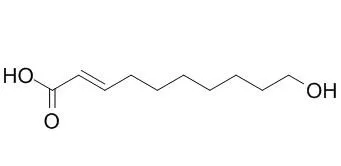| In vitro: |
| J Eur Acad Dermatol Venereol. 2013 Oct;27(10):1269-77. | | 10-Hydroxy-2-decenoic acid prevents ultraviolet A-induced damage and matrix metalloproteinases expression in human dermal fibroblasts.[Pubmed: 23030720] | 10-Hydroxy-2-decenoic acid (10-HDA) is a major fatty acid component of royal jelly, which has been reported to have a variety of beneficial pharmacological characteristics. However, the effects of 10-HDA on skin photoageing and its potential mechanism of action are unclear.
We investigated the protective effects of 10-HDA on ultraviolet (UV) A-induced damage in human dermal fibroblasts (HDFs). We then explored the inhibitory effects of 10-HDA on UVA-induced matrix metalloproteinases (MMPs) expression and elucidated the signalling pathways controlling MMPs inhibition.
METHODS AND RESULTS:
Primary human dermal fibroblasts were exposed to UVA. Cell proliferation, cellular senescent state and collagen content were analysed using CCK-8, senescence-associated β-galactosidase staining and Sircol collagen assay, respectively. Fluorometric assays were performed to detect the formation of reactive oxygen species (ROS) in the cells. The mRNA levels of MMP-1, MMP-3 and type I (α1) collagen were determined by quantitative real-time PCR. Western blot was applied to detect the expression of MMP-1, MMP-3, JNK and p38 MAPK.
HDFs treated with 10-HDA were significantly protected from UVA-induced cytotoxicity, ROS, cellular senescence and stimulated collagen production. Moreover, 10-HDA suppressed the UVA-induced expression of MMP-1 and MMP-3 at both the transcriptional and protein levels. Treatment with 10-HDA also reduced the UVA-induced activation of the JNK and p38 MAPK pathways.
CONCLUSIONS:
The data obtained in this study provide evidence that 10-HDA could prevent UVA-induced damage and inhibit MMP-1 and MMP-3 expressions. Therefore, 10-HDA may be a potential agent for the prevention and treatment of skin photoageing. | | Evid Based Complement Alternat Med. 2009 Dec;6(4):489-94. | | 10-Hydroxy-2-decenoic acid, a major fatty acid from royal jelly, inhibits VEGF-induced angiogenesis in human umbilical vein endothelial cells.[Pubmed: 18955252] | 10-Hydroxy-2-decenoic acid (10HDA), a major fatty acid component of RJ, is known to have various pharmacological effects; its antitumor activity being especially noteworthy. However, the mechanism underlying this effect is unclear.
METHODS AND RESULTS:
We examined the effect of 10-Hydroxy-2-decenoic acid on VEGF-induced proliferation, migration and tube formation in human umbilical vein endothelial cells (HUVECs). Our findings showed that, 10-Hydroxy-2-decenoic acid at 20 microM or more significantly inhibited such proliferation, migration and tube formation. Similarly, 10 microM GM6001, a matrix metalloprotease inhibitor, prevented VEGF-induced migration and tube formation.
CONCLUSIONS:
These findings indicate that 10-Hydroxy-2-decenoic acid exerts an inhibitory effect on VEGF-induced angiogenesis, partly by inhibiting both cell proliferation and migration. |
|






 Cell. 2018 Jan 11;172(1-2):249-261.e12. doi: 10.1016/j.cell.2017.12.019.IF=36.216(2019)
Cell. 2018 Jan 11;172(1-2):249-261.e12. doi: 10.1016/j.cell.2017.12.019.IF=36.216(2019) Cell Metab. 2020 Mar 3;31(3):534-548.e5. doi: 10.1016/j.cmet.2020.01.002.IF=22.415(2019)
Cell Metab. 2020 Mar 3;31(3):534-548.e5. doi: 10.1016/j.cmet.2020.01.002.IF=22.415(2019) Mol Cell. 2017 Nov 16;68(4):673-685.e6. doi: 10.1016/j.molcel.2017.10.022.IF=14.548(2019)
Mol Cell. 2017 Nov 16;68(4):673-685.e6. doi: 10.1016/j.molcel.2017.10.022.IF=14.548(2019)